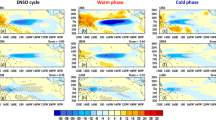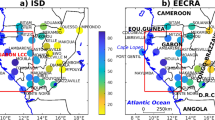Abstract
Like many other coupled models, the Flexible coupled General Circulation Model (FGCM-0) suffers from the spurious “Double ITCZ”. In order to understand the “Double ITCZ” in FGCM-0, this study first examines the low-level cloud cover and the bulk stability of the low troposphere over the eastern subtropical Pacific simulated by the National Center for Atmospheric Research (NCAR) Community Climate Model version 3 (CCM3), which is the atmosphere component model of FGCM-0. It is found that the bulk stability of the low troposphere simulated by CCM3 is very consistent with the one derived from the National Center for Environmental Prediction (NCEP) reanalysis, but the simulated low-level cloud cover is much less than that derived from the International Satellite Cloud Climatology Project (ISCCP) D2 data. Based on the regression equations between the low-level cloud cover from the ISCCP data and the bulk stability of the low troposphere derived from the NCEP reanalysis, the parameterization scheme of low-level cloud in CCM3 is modified and used in sensitivity experiments to examine the impact of low-level cloud over the eastern subtropical Pacific on the spurious “Double ITCZ” in FGCM-0. Results show that the modified scheme causes the simulated low-level cloud cover to be improved locally over the cold oceans. Increasing the low-level cloud cover off Peru not only significantly alleviates the SST warm biases in the southeastern tropical Pacific, but also causes the equatorial cold tongue to be strengthened and to extend further west. Increasing the low-level cloud fraction off California effectively reduces the SST warm biases in ITCZ north of the equator. In order to examine the feedback between the SST and low-level cloud cover off Peru, one additional sensitivity experiment is performed in which the SST over the cold ocean off Peru is restored. It shows that decreasing the SST results in similar impacts over the wide regions from the southeastern tropical Pacific northwestwards to the western/central equatorial Pacific as increasing the low-level cloud cover does.
Similar content being viewed by others
References
Bonan, G. B., 1998: The land surface climatology of the NCAR land surface model coupled to the NCAR community climate model.J. Climate,11, 1307–1326.
da Silva, A. M., C. C. Young, and S. Levitus, 1994:Atlas of Surface Marine Data 1994, Vol.1: Algorithms and Procedures, NOAA Atlas NECDIS 6, U. S. Dept. of Commerce, Washington D. C., 83pp.
Gent, P. R., and J. C. McWilliams, 1990: Isopycnal mixing in ocean circulation models.J. Phys. Oceanogr.,20, 150–155.
Gordon, C. T., A. Rosati, and R. Gudgel, 2000: Tropical sensitivity of a coupled model to specified ISCCP low clouds.J. Climate,13, 2239–2260.
Haney, R. L., 1971: Surface thermal boundary condition for ocean circulation models.J. Phys. Oceanogr.,1, 241–248.
Hellerman, S., and M. Rosenstein, 1983: Normal monthly wind stress data over the world ocean with error estimates.J. Phys. Oceanogr.,13, 1093–1104.
Jin Xiangze, Zhang Xuehong, and Zhou Tianjun, 1999: Fundamental framework and experiments of the third generation of IAP/LASG world ocean general circulation model.Advances in Atmospheric Sciences,16(2), 197–215.
Kalnay, E., and Coauthors, 1996: The NCEP/NCAR 40-year reanalysis project.Bull. Amer. Meteor. Soc.,77, 437–471.
Kiehl, J. F., J. J. Hack, G. B. Bonan, B. A. Boville, D. L. Williamson, and P. J. Pasch, 1998: The National Center for Atmospheric Research community climate model: CCM3.J. Climate,11, 1131–1149.
Klein, S. A., and D. L. Hartmann, 1993: The seasonal cycle of low stratiform clouds.J. Climate,6, 1587–1606.
Levitus, S., and T. P. Boyer, 1994:World Ocean Atlas 1994 Volume 3: Salinity, NOAA Atlas NESDIS3. U. S. Department of Commerce, Washington, D. C., 99pp.
Li Jianglong, 2002: Analysis of double ITCZ phenomena in a coupled ocean-atmosphere general circulation model. M. S. thesis, Institute of Atmospheric Physics, Chinese Academy of Sciences, 65pp. (in Chinese)
Liu, Z., and S.-P. Xie, 1994: Equatorward propagation of coupled air-sea disturbances with application to the annual cycle of the eastern tropical Pacific.J. Atmos. Sci.,51, 3807–3822.
Liu Xiyong, 2001: The simulation and study of sea-ice-air interaction in the northern high latitude region. Ph.D. dissertation, Institute of Atmospheric Physics, Chinese Academy of Sciences, 136pp. (in Chinese)
Ma, C. C., Carlos R. Mechoso, Andrew W. Robertson, and Akio Arakawa, 1996: Peruvian stratus clouds and the tropical Pacific circulation: A coupled ocean-atmosphere GCM study.J. Climate,9, 1635–1645.
Mechoso, C. R., and Coauthors, 1995: The seasonal cycle over the tropical Pacific in coupled ocean-atmosphere general circulation models.Mon. Wea. Rev.,123, 2825–2838.
Pacanowski, R. C., and G. Philander, 1981: Parameterization of vertical mixing in numerical models of the tropical ocean.J. Phys. Oceanogr.,11, 1442–1451.
Parkinson, C. L., and W. M. Washington, 1979: A large-scale numerical model of sea ice.J. Geophys. Res.,84, 311–337.
Philander, S. G. H., D. Gu, D. Halpern, G. Lambert, N. C. Lau, T. Li, and R. C. Pacanowski, 1996: Why the ITCZ is mostly north of the equator.J. Climate,9, 2958–2972.
Rosati, A., and K. Miyakoda, 1988: A general circulation model for upper ocean circulation.J. Phys. Oceanogr.,18, 1601–1626.
Rossow, W. B., and R. A. Schiffer, 1991: ISCCP cloud data products.Bull. Amer. Meteor. Soc.,72, 2–20.
Rossow, W. B., A. W. Walker, D. E. Beuschel, and M. D. Roiter, 1996: International Satellite Cloud Climatology Project (ISCCP) documentation of new cloud datasets. WMO/TD-No.737, World Meteorological Organization, Geneva, Switzerland, 115pp.
Shea, D. J., K. E. Trenberth, and R. W. Reynolds, 1990: A global monthly mean sea surface temperature climatology. NCAR Tech. Note NCAR/TN-345, 167pp.
Slingo, J. M., 1987: The development and verification of a cloud prediction scheme for the ECMWF model.Quart. J. Roy. Meteor. Soc.,113, 899–927.
Slingo, A., and J. M. Slingo, 1991: Response of the National Center for Atmospheric Research community climate model to improvements in the representation of clouds.J. Geophys. Res.,96, 15341–15357.
Weatherly, J. W., B. P. Briegleb, W. G. Large, and J. A. Maslanik, 1998: Sea ice and polar climate in the NCAR CSM.J. Climate,11, 1472–1486.
Yu, J.-Y., and C. R. Mechoso, 1999: Links between annual variations of Peruvian stratocumulus clouds and of SST in the eastern equatorial Pacific.J. Climate,12, 3305–3318.
Yu Yongqiang, Yu Rucong, Zhang Xuehong, and Liu Hailong, 2002: A flexible coupled ocean-atmosphere general circulation model.Advances in Atmospheric Sciences,19(1), 169–190.
Zhang Chidong, 2001: Double ITCZs.J. Geophys. Res.,106, 11785–11792.
Author information
Authors and Affiliations
Rights and permissions
About this article
Cite this article
Dai, F., Yu, R., Zhang, X. et al. The impact of low-level cloud over the eastern subtropical Pacific on the “Double ITCZ” in LASG FGCM-0. Adv. Atmos. Sci. 20, 461–474 (2003). https://doi.org/10.1007/BF02690804
Received:
Revised:
Issue Date:
DOI: https://doi.org/10.1007/BF02690804




